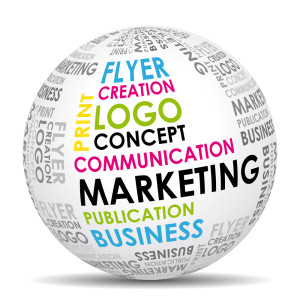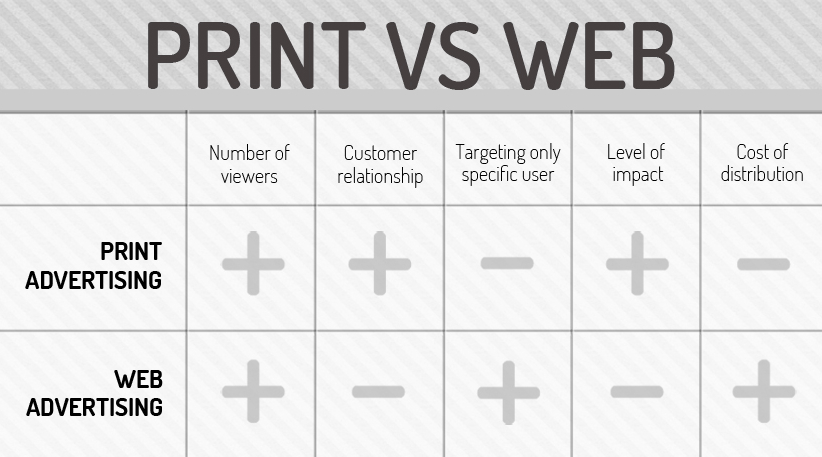It used to be much simpler to organize your marketing budget. There would be print publications like the Yellow Pages, as well as trade magazines, newspapers, radio, direct mail, and maybe even television. A business owner knew that, if they allocated their budget across these forums, they’d be reaching a large percentage of the population.
But that was before the rise of the Internet and social media. Suddenly there was a need to have your own website, promote your business online, rank on Google and other search engines, and manage your social media presence on Facebook, Twitter, Pinterest and more. It became much more time consuming for the marketing manager and, for the small business owner, nearly impossible to keep up.
 Many businesses were creating an online presence that, with no cohesive strategy, portrayed an incongruence with their offline branding. This sent an unclear message to their customers, as often the person updating web media was different to that of print. There was no clear roadmap or direction, and this is where the problem lay.
Many businesses were creating an online presence that, with no cohesive strategy, portrayed an incongruence with their offline branding. This sent an unclear message to their customers, as often the person updating web media was different to that of print. There was no clear roadmap or direction, and this is where the problem lay.
This isn’t to say that the same message should be relayed across all forums. On the contrary, the tone and rhetoric must be sculpted to suit the source. Social media is by nature more informal and, especially in Twitter’s case, direct. Replicating a print article on a website means losing out on the latter’s dynamic capacity, alongside the need to incorporate SEO.
Several factors affect the mix of print and online, including a company’s organizational culture, personnel and staff capabilities, technology infrastructure and the prevalent media mix, both locally and where growth opportunities lie. Some products are best promoted through one medium or another, depending on target audience demographics and the complexity of the product. However, integrating (that isn’t copying) online and print media messages can be very beneficial, and increase the effectiveness of the campaign when compared to using one or the other. Let’s look at a few examples.
Print Advertisements and Web
Using local press and mailshots to deliver a promotion or deal remains a common marketing tactic today. Mailshots can target households of customers or businesses, and newspaper adverts can broaden a message’s reach. However, it’s often hard to measure the success of these methods, and marketers can reduce fulfillment costs and increase customer convenience by facilitating online ordering. The print promotion simply carries a code for a special offer, such as a discount, a free gift, or free shipping. The code must be entered into the website and acts as an incentive for the customer to use an online store, typically a more efficient way for marketers to receive orders.

Brochure and Web Landing Pages
When businesses create print brochures, they’ll often include their company web address. However, that will take the customer to a business overview and not the specific topic. The reach of that brochure can be extended by including a URL or QR code for a dedicated web landing page that supports and adds to the marketing message. This has two benefits: first, it gives the buyer an easy way to show interest in that promotion and, second, it again allows online tracking of an offline medium.
Direct Mail and Email
If you have access to both email and a physical address, utilizing that powerful combination is much more effective than simply using one alone. An email can be sent as an original teaser, introducing the prospective buyer to the promotion and highlighting a direct mail piece will arrive soon. This means the direct mail will less likely be disposed of, and a follow up email can reinforce the message and encourage a response.
When it comes to integrating print and web advertising, these are just three ways to do it. Remember, it is not a matter of repeating a message online, nor of having completely unassociated messages in different mediums. What’s important is having a cohesive, structured and organized marketing campaign. Each message must support and build on that of another, increasing the effectiveness and therefore the overall return on investment. Image Credit: Under 30 CEO and Tannersville
It used to be much simpler to organize your marketing budget. There would be print publications like the Yellow Pages, as well as trade magazines, newspapers, radio, direct mail, and maybe even television. A business owner knew that, if they allocated their budget across these forums, they’d be reaching a large percentage of the population.
But that was before the rise of the Internet and social media. Suddenly there was a need to have your own website, promote your business online, rank on Google and other search engines, and manage your social media presence on Facebook, Twitter, Pinterest and more. It became much more time consuming for the marketing manager and, for the small business owner, nearly impossible to keep up.
 Many businesses were creating an online presence that, with no cohesive strategy, portrayed an incongruence with their offline branding. This sent an unclear message to their customers, as often the person updating web media was different to that of print. There was no clear roadmap or direction, and this is where the problem lay.
Many businesses were creating an online presence that, with no cohesive strategy, portrayed an incongruence with their offline branding. This sent an unclear message to their customers, as often the person updating web media was different to that of print. There was no clear roadmap or direction, and this is where the problem lay.
This isn’t to say that the same message should be relayed across all forums. On the contrary, the tone and rhetoric must be sculpted to suit the source. Social media is by nature more informal and, especially in Twitter’s case, direct. Replicating a print article on a website means losing out on the latter’s dynamic capacity, alongside the need to incorporate SEO.
Several factors affect the mix of print and online, including a company’s organizational culture, personnel and staff capabilities, technology infrastructure and the prevalent media mix, both locally and where growth opportunities lie. Some products are best promoted through one medium or another, depending on target audience demographics and the complexity of the product. However, integrating (that isn’t copying) online and print media messages can be very beneficial, and increase the effectiveness of the campaign when compared to using one or the other. Let’s look at a few examples.
Print Advertisements and Web
Using local press and mailshots to deliver a promotion or deal remains a common marketing tactic today. Mailshots can target households of customers or businesses, and newspaper adverts can broaden a message’s reach. However, it’s often hard to measure the success of these methods, and marketers can reduce fulfillment costs and increase customer convenience by facilitating online ordering. The print promotion simply carries a code for a special offer, such as a discount, a free gift, or free shipping. The code must be entered into the website and acts as an incentive for the customer to use an online store, typically a more efficient way for marketers to receive orders.

Brochure and Web Landing Pages
When businesses create print brochures, they’ll often include their company web address. However, that will take the customer to a business overview and not the specific topic. The reach of that brochure can be extended by including a URL or QR code for a dedicated web landing page that supports and adds to the marketing message. This has two benefits: first, it gives the buyer an easy way to show interest in that promotion and, second, it again allows online tracking of an offline medium.
Direct Mail and Email
If you have access to both email and a physical address, utilizing that powerful combination is much more effective than simply using one alone. An email can be sent as an original teaser, introducing the prospective buyer to the promotion and highlighting a direct mail piece will arrive soon. This means the direct mail will less likely be disposed of, and a follow up email can reinforce the message and encourage a response.
When it comes to integrating print and web advertising, these are just three ways to do it. Remember, it is not a matter of repeating a message online, nor of having completely unassociated messages in different mediums. What’s important is having a cohesive, structured and organized marketing campaign. Each message must support and build on that of another, increasing the effectiveness and therefore the overall return on investment. Image Credit: Under 30 CEO and Tannersville
 Many businesses were creating an online presence that, with no cohesive strategy, portrayed an incongruence with their offline branding. This sent an unclear message to their customers, as often the person updating web media was different to that of print. There was no clear roadmap or direction, and this is where the problem lay.
Many businesses were creating an online presence that, with no cohesive strategy, portrayed an incongruence with their offline branding. This sent an unclear message to their customers, as often the person updating web media was different to that of print. There was no clear roadmap or direction, and this is where the problem lay.




